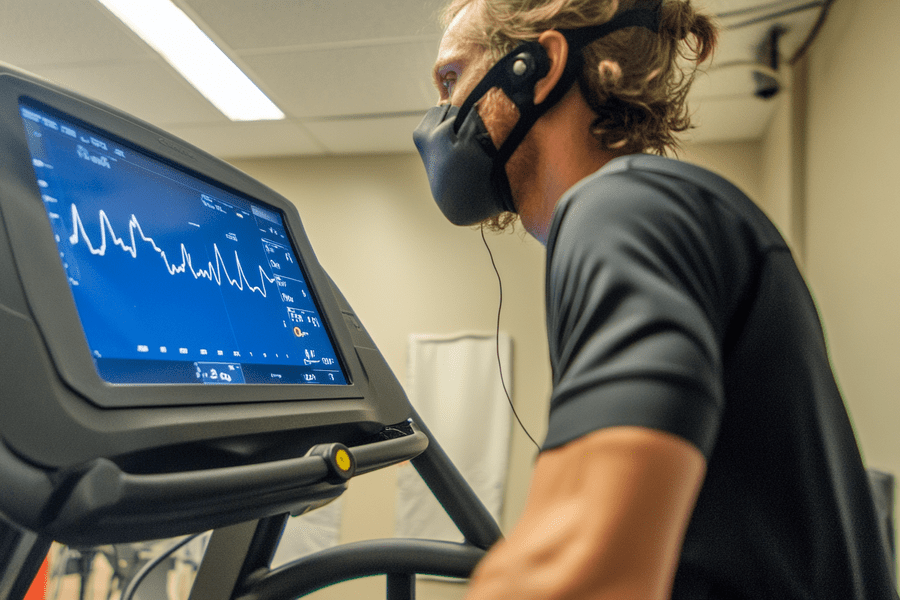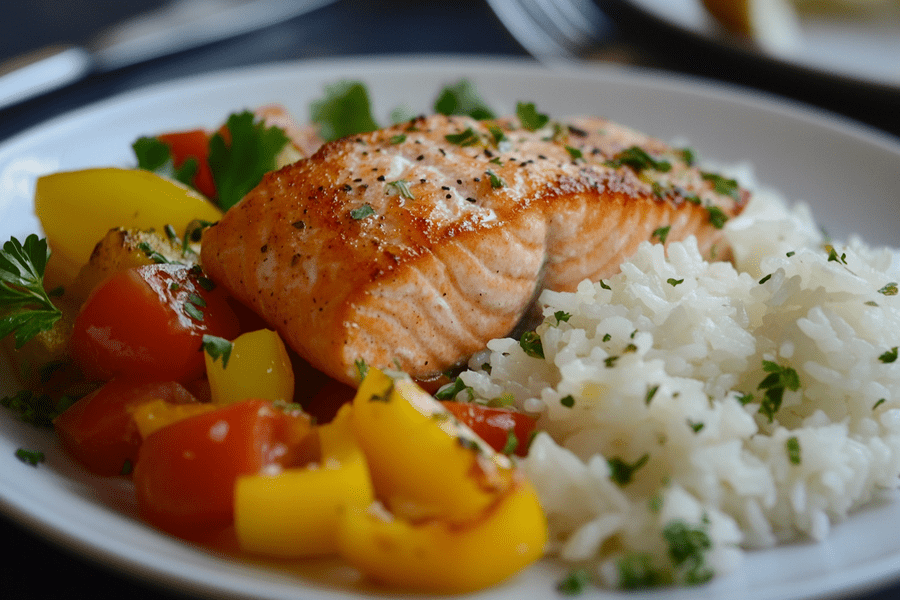
VO2 max is a crucial measure of cardiovascular fitness that indicates how efficiently your body uses oxygen during intense exercise. Improving your VO2 max can lead to enhanced athletic performance and better overall health.
To increase your VO2 max, engage in high-intensity interval training (HIIT) and incorporate regular endurance exercises into your routine. These exercises challenge your cardiovascular system, pushing it to adapt and become more efficient at utilising oxygen.
Consistency is key when working to improve your VO2 max. Aim for at least three to four sessions of intense aerobic exercise per week, gradually increasing the duration and intensity of your workouts. By focusing on these targeted exercises, you can boost your VO2 max and elevate your fitness level to new heights.
Contents
Understanding VO2 Max
VO2 max measures the maximum amount of oxygen your body can utilise during intense exercise. It reflects your cardiovascular fitness and endurance capacity.
Concept and Importance
VO2 max stands for the maximum volume of oxygen your body can consume and use during exercise. It’s expressed in millilitres of oxygen per kilogram of body weight per minute (ml/kg/min).
A higher VO2 max indicates better aerobic capacity and cardiovascular fitness. This means your body can deliver and use more oxygen efficiently during physical activity.
VO2 max is crucial for endurance athletes but also benefits everyday health. It’s linked to lower risks of heart disease and increased longevity.
Measuring VO2 max typically involves exercising at increasing intensities while wearing a mask to analyse breath.
Biological Factors Affecting VO2 Max
Several biological factors influence an individual’s VO2 max:
- Genetics: Inherited traits play a significant role in determining one’s VO2 max potential.
- Age: VO2 max tends to decline with age, typically decreasing by about 10% per decade after age 30.
- Gender: Men generally have higher VO2 max values than women due to differences in body composition and heart size.
- Lung capacity: Larger lungs can take in more oxygen, potentially contributing to a higher VO2 max.
- Heart size and function: A stronger heart can pump more oxygenated blood to muscles.
- Muscle fibre composition: A higher proportion of slow-twitch muscle fibres may contribute to better oxygen utilisation.
Training can improve VO2 max, but individual genetic potential limits the extent of improvement.
Assessment and Measurement
Accurately gauging VO2 max involves various methods, from precise laboratory tests to accessible field assessments and modern technological solutions. These approaches provide insights into cardiovascular fitness and help track progress over time.
Laboratory Tests
Laboratory tests offer the most accurate VO2 max measurements. These tests typically involve exercising on a treadmill or stationary bike whilst wearing a mask connected to a gas analyser. The equipment measures oxygen consumption and carbon dioxide production during incremental exercise.
A common protocol involves increasing the intensity every few minutes until exhaustion. Throughout the test, heart rate, blood pressure, and perceived exertion are monitored. The highest oxygen consumption value achieved is considered the VO2 max.
Whilst highly accurate, laboratory tests require specialised equipment and trained personnel. They can be expensive and are usually conducted in clinical or research settings.
Field Tests
Field tests provide practical alternatives for estimating VO2 max outside of laboratory settings. These tests are more accessible and can be performed with minimal equipment.
The Cooper 12-minute run test involves covering as much distance as possible in 12 minutes. The distance is then used to estimate VO2 max. Another option is the Rockport Walking Test, where participants walk one mile as quickly as possible.
The Beep Test, or Multi-Stage Fitness Test, involves running between two points 20 metres apart at increasing speeds. The level achieved correlates with VO2 max.
Whilst less precise than laboratory tests, field assessments offer practical insights into cardiovascular fitness.
Technology in Monitoring
Advancements in wearable technology have made VO2 max estimation more accessible. Many fitness trackers and smartwatches now offer VO2 max estimates based on heart rate data and user information.
Devices from brands like Garmin use proprietary algorithms to calculate VO2 max during outdoor running or cycling activities. These estimates consider factors such as heart rate, pace, and terrain.
Online calculators also provide VO2 max estimates based on input data like age, resting heart rate, and exercise performance. Whilst convenient, these technological solutions may not be as accurate as direct measurements.
Regular monitoring using these devices can help track changes in cardiovascular fitness over time, providing motivation and guidance for training programs.
Training Methods to Improve VO2 Max

To enhance VO2 max, incorporating specific training methods is crucial. These approaches target different physiological aspects to boost overall cardiovascular fitness and oxygen utilisation.
High-Intensity Interval Training (HIIT)
HIIT is a powerful method for improving VO2 max. This technique involves alternating short bursts of intense exercise with brief recovery periods. A typical HIIT session might include 30 seconds of all-out effort followed by 30 seconds of rest, repeated for 15-20 minutes.
HIIT can be applied to various activities:
- Running: Sprints on a track or treadmill
- Cycling: Fast pedalling on a stationary bike or outdoor cycling
- Swimming: Quick laps followed by slower recovery swims
The high-intensity periods push the cardiovascular system to its limits, forcing it to adapt and improve oxygen utilisation. This leads to increased VO2 max over time.
Continuous Aerobic Exercise
While HIIT is effective, continuous aerobic exercise also plays a vital role in VO2 max improvement. This method involves sustained moderate-intensity activity for extended periods.
Recommended activities include:
- Long-distance running
- Cycling at a steady pace
- Swimming laps continuously
The key is to maintain a challenging but sustainable pace for 30-60 minutes. This type of training enhances the body’s ability to utilise oxygen efficiently over prolonged periods, contributing to improved VO2 max.
Gradually increasing the duration and intensity of these sessions can lead to significant gains in aerobic capacity.
Tempo Workouts
Tempo workouts bridge the gap between HIIT and continuous aerobic exercise. These sessions involve maintaining a ‘comfortably hard’ pace for an extended period, typically 20-40 minutes.
A tempo workout might consist of:
- 10-minute warm-up at an easy pace
- 20-30 minutes at tempo pace (about 80-85% of maximum heart rate)
- 10-minute cool-down at an easy pace
Tempo training improves lactate threshold, allowing the body to sustain higher intensities for longer periods. This translates to enhanced VO2 max as the body becomes more efficient at processing oxygen during intense exercise.
Regular incorporation of tempo workouts can significantly boost overall cardiovascular fitness and VO2 max.
Influence of Lifestyle on VO2 Max
Lifestyle choices significantly impact VO2 max, a key measure of cardiovascular fitness. Nutrition, sleep, and stress management play crucial roles in optimising oxygen utilisation during exercise.
Nutrition and Diet

A balanced diet supports VO2 max improvement. High-intensity training requires adequate fuel, making proper nutrition essential.
Protein intake aids muscle recovery and growth. Aim for 1.2-2.0 grams per kilogram of body weight daily.
Carbohydrates are vital for energy during intense workouts. Complex carbs like whole grains provide sustained energy.
Healthy fats support hormone production and reduce inflammation. Include sources like avocados, nuts, and olive oil.
Hydration is crucial. Water helps transport oxygen throughout the body. Drink at least 2-3 litres daily, more during exercise.
Antioxidant-rich foods combat exercise-induced oxidative stress. Berries, leafy greens, and colourful vegetables are excellent choices.
Sleep and Recovery
Quality sleep is essential for VO2 max improvement. It allows the body to repair and adapt to training stresses.
Adults should aim for 7-9 hours of sleep nightly. Consistency in sleep patterns supports optimal recovery.
Sleep quality affects exercise performance and VO2 max. Create a relaxing bedtime routine and maintain a cool, dark sleeping environment.
Active recovery, such as light jogging or swimming, can enhance blood flow and aid muscle repair between intense workouts.
Proper recovery prevents overtraining, which can negatively impact VO2 max. Listen to your body and include rest days in your training schedule.
Stress and Rest
Chronic stress can hinder VO2 max improvement. High stress levels increase cortisol, potentially impacting exercise performance.
Incorporate stress-reduction techniques like meditation, yoga, or deep breathing exercises into daily routines.
Balance intense training with adequate rest. Rest days allow for physiological adaptations that improve VO2 max.
Intermittent fasting may support metabolic health and potentially boost VO2 max. Consult a healthcare professional before making significant dietary changes.
Avoid excessive alcohol consumption, as it can interfere with sleep quality and recovery processes.
Regular health check-ups ensure optimal overall health, supporting VO2 max improvement efforts.
Long-Term Development and Plateaus
Improving VO2 max requires consistent effort over an extended period. Athletes may experience rapid initial gains followed by slower progress as they approach their physiological limits.
Progressive Training
To enhance VO2 max over time, athletes should focus on high-intensity workouts. These efforts trigger physiological adaptations that boost cardiovascular fitness. Interval training, tempo runs, and hill repeats are effective methods for stimulating VO2 max improvements.
Gradually increasing training volume and intensity is crucial. A structured plan might involve:
- Week 1-4: 2 high-intensity sessions per week
- Week 5-8: 3 high-intensity sessions per week
- Week 9-12: 4 high-intensity sessions per week
Rest and recovery are equally important. Overtraining can lead to burnout and hinder progress.
Understanding Plateaus
As athletes approach their genetic potential, VO2 max improvements may slow or stall. This plateau is a natural part of the training process. It occurs due to the law of diminishing returns, where each additional unit of effort yields progressively smaller gains.
To overcome plateaus:
- Vary training stimuli
- Focus on other aspects of fitness (e.g., lactate threshold)
- Ensure proper nutrition and recovery
It’s important to recognise that VO2 max is just one component of endurance performance. Other factors, such as running economy and mental toughness, also play crucial roles in athletic success.
Frequently Asked Questions
VO2 max improvement strategies extend beyond running. Various exercises, breathing techniques, and cycling methods can enhance this vital fitness measure. Age influences VO2 max scores, and improvement timelines vary.
What exercises can enhance VO2 max without running?
High-intensity interval training (HIIT) is an excellent alternative to running for boosting VO2 max. This can include exercises like burpees, mountain climbers, and jump squats.
Swimming is another effective low-impact option. It engages the entire body and challenges the cardiovascular system.
Rowing machines provide a full-body workout that can significantly improve VO2 max. They offer a combination of strength and endurance training.
Which breathing techniques are effective for elevating VO2 max?
Diaphragmatic breathing, also known as belly breathing, can enhance oxygen uptake. It involves deep inhalation through the nose, expanding the diaphragm.
Rhythmic breathing, synchronising breaths with movement during exercise, can improve oxygen efficiency. This technique is particularly useful during activities like running or cycling.
Pursed-lip breathing can help increase lung capacity. It involves inhaling through the nose and exhaling slowly through pursed lips.
How can cycling contribute to increasing VO2 max?
Cycling is an excellent aerobic exercise for improving VO2 max. Interval training on a bike can be particularly effective.
Hill climbs on a bicycle challenge the cardiovascular system and can boost VO2 max. These can be done outdoors or simulated on a stationary bike.
Long, steady-state rides at moderate intensity can also contribute to VO2 max improvements over time.
What are the most efficient methods to raise VO2 max?
High-intensity interval training (HIIT) is widely regarded as one of the most efficient methods. It involves short bursts of intense exercise followed by recovery periods.
Combining endurance training with strength exercises can yield significant improvements. This approach helps build both cardiovascular fitness and muscle endurance.
Consistent, progressive overload in aerobic activities is key. Gradually increasing workout duration and intensity over time challenges the body to adapt.
Over what period can one expect to see improvements in VO2 max?
Initial improvements in VO2 max can be seen in as little as 4-6 weeks with consistent training. However, significant changes typically occur over 3-6 months.
The rate of improvement varies based on factors such as initial fitness level, age, and training intensity. Beginners often see faster initial gains.
Continued improvement can occur for years with proper training, though the rate of increase tends to slow over time.
How does age impact a good VO2 max score?
VO2 max naturally declines with age, typically decreasing by about 10% per decade after the age of 30.
For men aged 20-29, a good VO2 max score is generally considered to be between 49-55 ml/kg/min. For women in the same age group, 43-52 ml/kg/min is considered good.
In the 50-59 age group, good scores for men range from 35-41 ml/kg/min, while for women, 28-33 ml/kg/min is considered good.
